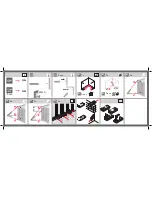
GasCheck 3000 & 3000is Ion Science Ltd
Page
16 of 23
4.5
Switch on the Gas Check
Press key and wait for GasCheck to bleep & flash, the display to light up and show “zeroing detector”.
When not detecting leaking gas, GasCheck still flashes and bleeps periodically to indicate that it is ON.
GasCheck remembers the settings on instrument power off so that the operator rarely if ever has to alter
any of them. The settings for gas group, auto range, peak hold and nozzle are shown on the display.
The response of GasCheck can readily be checked against an Ion Science CalCheck traceable calibration
accessory.
4.6
Recommended leak search procedure
4.6.1
General procedure
Note: When you use the GasCheck, do not allow dirt or debris to enter the end of the probe or nozzle. If the
probe or nozzle is blocked, the GasCheck will not operate correctly.
The following test procedures assume that you have fitted the short probe. The response time of the
GasCheck increases from about 1 second or less when the short probe is fitted to about 9 seconds when the
long probe is fitted. If you use the long probe for leak detection, ensure that you move the end of the probe
much more slowly along the area you leak test.
Ensure the part under test contains a reasonable percentage of a trace gas that is different from normal air!
Move the end of the probe (or nozzle) around the area of a suspected leak and look at the display (or listen
to the audible clicks or note the visual LED flash rate on the GasCheck) to identify the location of a leak.
Specific procedures for leak detection along seams and around pipe joints are described in the following
sections.
When required:
Use the peak hold and Auto-Ranging modes to continue to check for leaks, but to display the largest
leak detected
If you want to zero the GasCheck, move the end of the probe (or nozzle) away from any possible leak,
into a clean air zone, then press the manual zero key: refer to Section 4.1.
Note that leak sensitivity depends on the ambient conditions. If you want to accurately measure a leak,
compare the indicated leak with a calibration standard, such as a CalCheck: see Section 7.3.
When the GasCheck indicates that a leak has been found, move the probe (or nozzle) back to determine the
precise location of the leak. The leak is located where the largest leak size is indicated on the display and
where highest frequency clicks and visual flashing rate are emitted by the GasCheck, on the current range.
4.6.2
Leak detection along seams
Move the end of the GasCheck probe (or nozzle) along the length of the seam, so that it just rests on the
seam. The speed at which you move along the seam depends upon the size of the leak that you search for:
If the leak is large, you can move fairly fast along the seam, at approximately 25 mm per second.
If the leak is small, move slowly along the seam, at approximately 10 mm per second.
















































